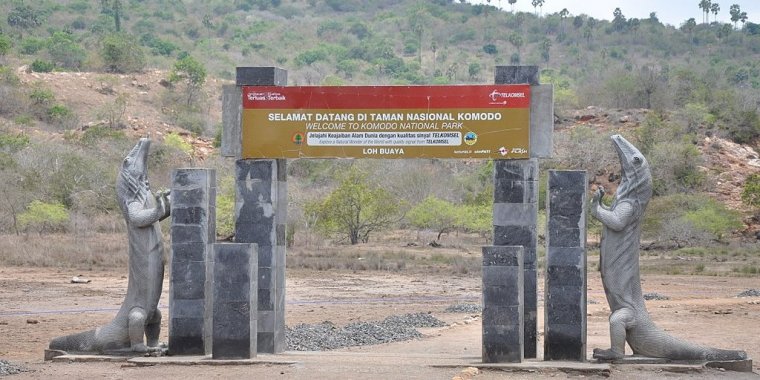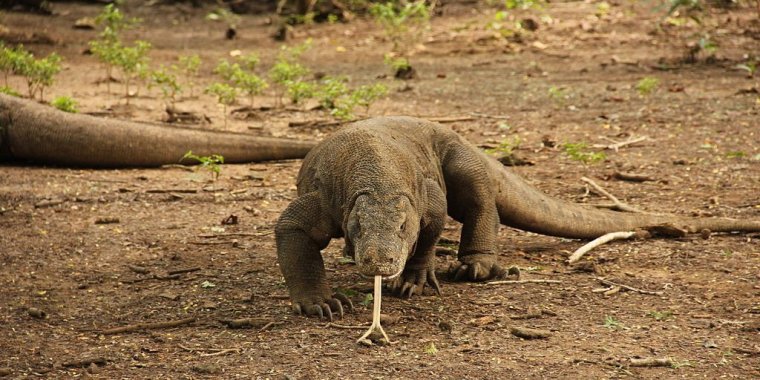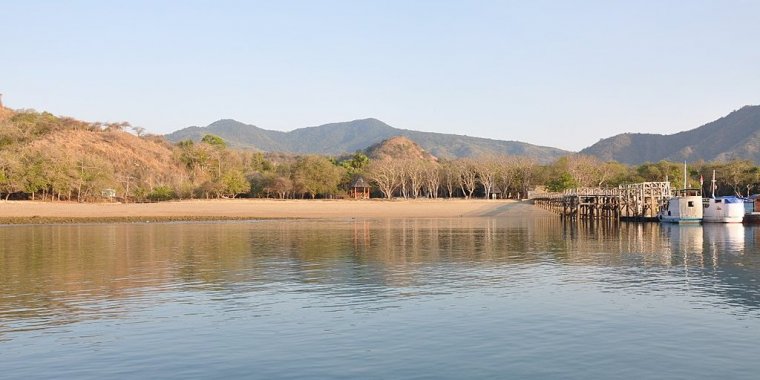| Published in Attractions / Places of Interest |
Komodo National Park, Indonesia

Welcome sign at the entrance to Komodo National Park, Rinca island. ![]()
Komodo National Park lies in the Wallacea Region of Indonesia, identified by both the WWF and Conservation International as a global conservation priority area, and is located in the centre of the Indonesian archipelago, between the islands of Sumbawa and Flores.
Komodo National Park includes three major islands: Komodo, Rinca and Padar, as well as numerous smaller islands creating a total surface area (marine and land) of more than 1,800 km². The boundaries include part of the island of Flores, where there are actually even more dragons than on Komodo itself.
As well as being home to the Komodo Dragon, also known as the Komodo Monitor, or Ora (to Indonesians), the park provides refuge for many other notable terrestrial species. Moreover, the Park includes one of the richest marine environments.
Komodo National Park was established in 1980 and was declared a UNESCO World Heritage Site and a Man and Biosphere Reserve by UNESCO in 1986, both indications of the park's biological importance.
Flora and fauna
The number of terrestrial animal species found in the park is not high, but the area is important from a conservation perspective as some species are endemic. Many of the mammals are Asiatic in origin. Several of the reptiles and birds are Australian in origin. These include the orange-footed scrubfowl, the lesser sulphur-crested cockatoo and the nosy friarbird.
The most famous of Komodo National Park's animals is the Komodo Dragon (Varanus komodoensis). It is the world's largest living lizard and can reach 3 m or more in length and weigh over 70 kg.
Other animals include the Timor deer, the main prey of the Komodo dragon, wild horses (kuda liar), water buffalo, wild boar (babi liar), long-tailed macaques, palm civets, the endemic Rinca rat (Tikus besar rinca), and fruit bats.
Also beware of the snakes inhabiting the island, including the cobra and Russel’s pit viper, both of which are extremely dangerous.
As far as the marine fauna is concerned, Komodo National Park includes one of the world's richest marine environments. It consists of over 260 species of reef building coral, 70 species of sponges, crustaceans, cartilaginous (including manta ray and sharks) over 1,000 species of bony fishes, marine reptiles (including sea turtles), and marine mammals (dolphins, whales, and dugongs).
Climate
Tropical all year round, and both extremely hot and dry (over 40 °C) during August and September.
Get in
The ferry service (to and from the cities of Sape, on the eastern tip of Sumbawa, and Labuanbajo, on Flores) drops off passengers on Komodo once or twice every week. There is no port on the island, so passengers are unloaded onto small vessels which take them into the island's only village. (Some departures do not provide this service - check beforehand.)
Several daily flights are available between Denpasar Ngurah Rai airport (DPS) and the Komodo airport (LBJ) at Labuan Bajo. Round trip from Denpasar costs up to Rp 1,700,000.
Travellers coming in from Sape to the west (those travelling overland through Sumbawa and also those arriving at Bima airport) should note that the once-daily ferries from Sape (costs Rp 55,000) can be suspended indefinitely due to bad weather, so if you want to be sure of your travel arrangements, flying to Labuanbajo is a much safer bet. (If you get stranded at Sape, the best Bima airport will be able to offer is a flight back to Denpasar on Bali.)
Perama Tour. The Hunting Komodo by Camera trip leaves every six days from Lombok. The route is not really on open water because it travels along the coastal line and most importantly it has navigation and safety equipment. Stops are made along the way in Labuanbajo and Komodo. Price for a cabin is around Rp 4,000,000; deck class is Rp 3,000,000 where you get to sleep with a thin carpet.
Fees and permits
You need to buy the appropriate fees and permits at one of the park headquarters when you arrive on Rinca island or Komodo island. They are supposed to be valid for three days, even though the ticket might state otherwise. For foreign visitors, these are as follows (as of May 2012):
— Entrance fee Rp 50,000
— Conservation fee Rp 20,000
— Photo camera fee: Rp 50,000
— Video camera fee: Rp 150,000
— Ranger/guide for each island: Rp 80,000 (per group)
Additional fees include activities (eg. diving is Rp 75,000, snorkelling Rp 60,000), research and documentation for commercial purposes.
Get around
• On land: On foot, only, as there are neither roads nor motor transport.
• On sea: By chartered boat, only, as there are no regular connections. As of January 2014, common price for two days boat charter to Rinca island and Komodo island is Rp 2,000,000, always negotiate with the boat captain. The small boat can accommodate 4 people. There are also more luxurious cruises from Bali.
You may wish to wear long pants, sunglasses and a hat as you walk in the interior.
What to See and Do in Komodo National Park
The main reasons to travel to Komodo National Park are the Komodo Dragons, the superb beaches and the unspoilt corals. There are also wild pigs, monkeys and horses on Pulau Rinca, one of the two largest islands in the park.
If you return by sea at night, you can also see legions of flying foxes (fruit bats whose wing span may exceed 4 feet) flying in the twilight sky. At night on the Flores Sea, you also have a magnificent view of the stars.
Depending on the time you have available, one or more guided tours on the islands of Rinca and Komodo itself. It is neither permitted nor advisable to do any tours without local guides, as the Komodo Dragons are dangerous when they attack.
This area is inhabited by more than a thousand different fish species, making it one of the world’s richest marine habitats. You may also swim in the Flores Sea on your incoming or outgoing boat trip to one of the islands. Beware of sharp corals on the sea floor near some of the small islands.
• Kanawa Island Diving, Kanawa Island, Flores (on Kanawa Island an hour out of Labuan Bajo on the edge of the Komodo Marine Park). Based on Kanawa Island and working alongside Kanawa Beach Bungalows, 14 rustic bungalows located on the beach with restaurant and daily free transfer from Labuan Bajo. Offers daily 2 or 3 dive trips into the marine park as well as diving day and night from the beach on the house reef.
A full range of PADI courses from Discover Scuba to Divemaster. The position of the island on the edge of the marine park means a saving on travel time to the dive sites in the central and northern areas of Komodo Marine Park.
• Komodo Liveaboards. Komodo Dive Liveaboards (Rinca Islands Liveaboard) cruise gives divers the ability to explore some of the most pristine and diverse marine habitats on the planet, while living right on the Komodo Liveaboard diving boat.
• Komodo Kayaking, Eco-Lodge hotel. Many of the islands in the chain are either inaccessible to large boats or difficult to access. However with a sea kayak, you can travel anywhere you like. Into small grottos and bays, around rocky points and slowly above shallow reefs brimming with fish.
• Sea Kayaking and SUP'ing Komodo Islands, Komodo Islands. There are dozens of uninhabited islands within and just outside the Komodo National Park. Many of these are only accessible by unmotorised vessels such as sea kayaks and stand-up paddleboards (SUP). These trips are the only full supported expeditions in the park using proper expedition style sea kayaks, not sit on tops.
This agency uses these sit in kayaks as the seas can get turn from tranquil to treacherous quite quickly, and a proper sea kayak is the only vessel that can handle it safely. They also have a 20-m support boat. People taking this trip sleep on isolated beaches by pristine reefs, stay in safari style tents with bush showers and toilets available, and eat wonderful Indonesian cuisine. There are 3-day and 5-day sea kayak and SUP trips all year round with the best times of year for paddling between April and November. From AUD1800.
• Wicked Diving, Komodo (on Main Road in Labuan Bajo, directly below Gardena Hotel). Small dive centre in Labuan Bajo operating their own Komodo liveaboard for 3- and 6-day tours. Offering daytrips, training and snorkelling tours.
• Uber Scuba Komodo, Jl. Soekarno Hatta, Komodo National Park. Daily 07:00-20:00. A professionally run scuba diving center with extremely experienced staff, Uber Scuba is also the only Freediving/Apnea operator in Labuan Bajo. They offer daily diving and Komodo liveaboards too. Centrally located and very welcoming.
Buy
On Pulau Rinca near the park headquarters you may buy hand carved wooden komodo dragons along with park stickers and park t-shirts. Prices may be cheaper in Labuan Bajo, Flores than on Pulau Rinca.
Ombak Biru (Komodo Dancer), Kuta Poleng A3, Jalan Setiabudi, Kuta, Bali. A luxury liveaboard that is part of Dancer Fleet Inc., mainly offering 10 night trips to explore North & South Komodo and surrounding islands.
Eat and Drink
A limited selection of food is available near the park headquarters on Pulau Rinca, and the prices are not high by Western standards.
Under no circumstances drink any tap water. The tap water is not potable. Near park headquarters on Pulau Rinca, you may purchase water and soft drinks. If you go trekking into the island's interior be sure to take a large bottle of water with you. You will need it!
Sleep
• Lodging. There is a USD7 a night losmen in Labuan Bajo, Flores. Backpacker hostel in a dorm room starts from Rp 50,000.
• Kayaking and camping. The Komodo Islands are made famous by the greatest lizard on the planet, the Komodo Dragon. But the Komodo chain of islands offers so much more than this. Pristine reefs, uninhabited islands, white sandy beaches, marine life second to none and land life as fascinating as the Dragon itself.
Many of the islands in the chain are either inaccessible to large boats or difficult to access. However with a sea kayak, you can travel anywhere you like, such as into small grottos and bays, around rocky points and slowly above shallow reefs brimming with fish.
Stay safe
The Komodo Dragon has a history of attacking humans. Beware of getting too close, and if you are visiting via the park's office (which you should), ask for a guide and stick close to him. Do not wander off or do anything without his consent.
Komodos may approach the guest rest area during daily feeding time, but in this time, find a building (which are usually elevated) and stay clear from the railings. Komodos can and will jump to obtain food if necessary. Park rangers are usually present at these events and will deflect any Komodos trying to get in (which they can do).
You may be given a large pole with a split on the end, forming a "Y" shape. This can be used as a walking pole or for moving things on your path - however, if wild animals threaten, it can be used as a last form of defence (despite being hardly useful against Komodos). Overall, try keeping a watchful eye and steer clear of any wildlife.
Komodos are extremely dangerous if close enough. They can run faster than humans (and accelerate very quickly), so best not approach if necessary. Jumping into water (as Komodos are often found near the beach too) doesn't help either, as they can swim faster than humans, can dive, and can also swim against strong currents (in fact, sometimes Komodos are found on neighbouring islands, suspected of swimming there).
Zoologists used to believe that the main problem was the dragon's septic bite from the rampant bacteria residing in their mouth. More recently theories have been put forward that the Komodo Dragon is venomous, and that the biggest problem when bitten is shock and massive blood loss due to the ferocity of the bite. In either case, being bitten is not a good thing.
The absence of crocodiles on Komodo Island (due in part to a lack of suitable habitat) leave the Komodo dragons with no natural predators.
Younger Komodos may live in trees. While not as dangerous as their parents, they can still jump off suddenly and cause panic. Snakes, monitor lizards, and other animals are also present and may cause minor problems.
Saltwater crocodiles are not present on Komodo Island but they may be present on the surrounding islands and in the ocean. So take extra caution in any area with estuaries and river mouths because the islands are within the natural range of that species of crocodile. It was once believed by Indonesian natives that monitor lizards (including the Komodo dragon) were capable of warning humans of a crocodile's presence, but don't count on this for your safety. (Wikivoyage)
Go next
• Bali The Island of the Gods is one or two hour's flying time away from Flores, depending on the airport, and is a popular combination trip with Komodo.
• Flores island.
YOU MAY ALSO LIKE





 If you own or manage a travel-related business such as a hotel, a bed-and-breakfast, a restaurant, a pub or a cafeteria, you can create a web page for your business for free on Titi Tudorancea Travel Info. » |


